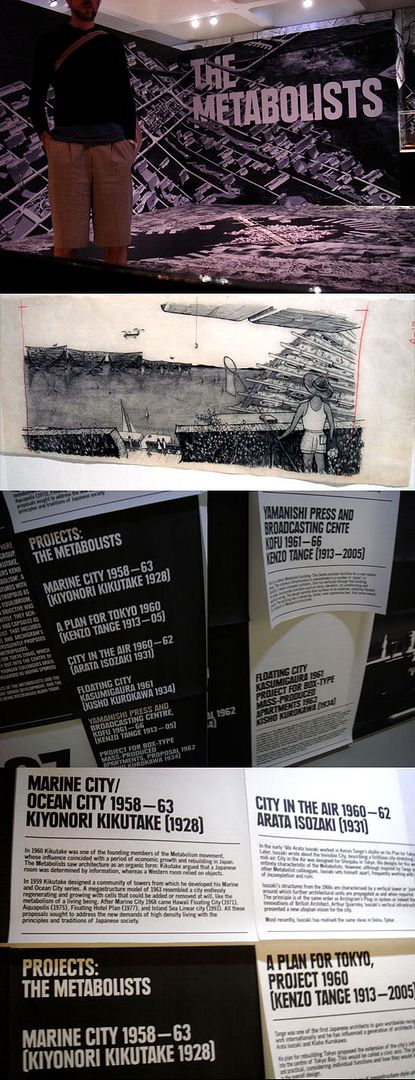The Metabolist

Friday, for me, was a day of blockbuster avant-architecture shows. The V&A's Modernism show and the Barbican's Future City show bounced off each other rather well. Both were concerned with a weird fusion of mechanistic-behavioristic science (the V&A show revealed a worrying worship of Henry Ford running through Modernism) and cranky utopian spirituality. Alongside standardization and Taylorism came freaky manifestos about how boiler suits would make every human being a work of art, or how modern civilization was all about doing naked socialist-fascist callisthenics with your comrades.
Despite its 1939 cut-off point, the V&A show petered out with an interesting section on the quirky, diversifying regional flavours of late Modernism -- Czech fabrics, Scandinavian furniture, and Brazilian architecture setting the scene for the eccentricites of Post-Modernism. And -- whoosh! -- the Barbican show picked up where Modernism left off, flipping Mies' "Less is more" motto into Venturi's riposte: "Less is a bore!"
In many ways Future City recapped the themes seen in the Mori Museum's Archilab show last year. But it was well laid-out, and illuminated corners of avant-archictecture I didn't know about.
Like, for instance? Well, like the Metabolists. From the blurb:
"Japan hosted the world design conference in 1960 and here Noboru Kawazue launched the avant-garde Metabolism Group... The group published "Metabolism", a booklet that connected the Metabolism of living creatures with that of architecture and the city. They saw the metropolis as being in a constantly changing state of dynamic equilibrium, in the same way as a living organism. Their main objective was to create structures that could expand infinitely. They achieved this by designing megastructures that had capsules as minimum dwelling units. Part of the zeitgeist that included Vona Friedman's Spatial Cities (1958-60) and Archigram's Plug-In City (1963-66), the Metabolists frequently proposed visionary schemes for floating or aerial metropolises. Kenzo Tange's plan for Tokyo (1960), which proposed a vast extension of the city out into the centre of Tokyo Bay, was an inspiration to his younger colleagues Arata Isozaki and Kisho Kurokawa and is regarded as having sparked the Metabolist movement. The achievements of the Metabolists laid the foundation for much subsequent urban development, and the breadth of their importance is being recognised again today."
I also liked Metabolist Kiyonori Kikutake's idea that "a Japanese room was determined by information, whereas a Western room relied on objects". My new apartment in Neukolln is going to be very "Japanese" in that sense: a corridor and two rooms stuffed to the gullet with information.